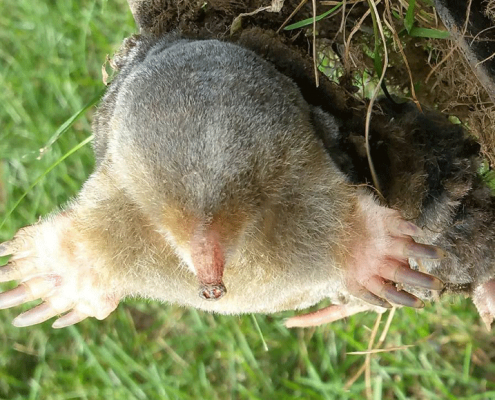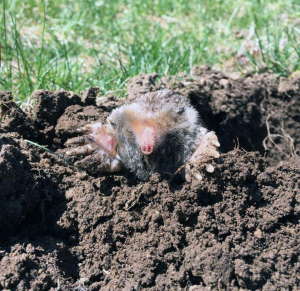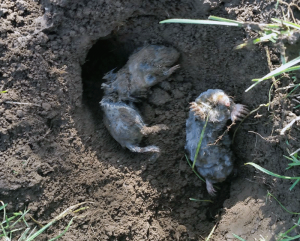
Belonging to the family, Talpidae, with about 42 species, moles are small mammals known for their appearance and burrowing activities. They are well distributed across America with 7 species domiciled in North America.
Species of moles found in the US include the Eastern mole which is hairless and short, the star-nosed mole which has 22 tentacle-like protrusions that surround the nose in a circle, and the hairy-tailed mole which has a long body that is covered with hair.
Mole Solutions
Mole Description
Although moles are rarely seen since they spend most of their time underground, their appearance is well documented. Their bodies are long and tubular with peculiar forelimbs; the shoulders and forelimbs of moles are typically oversized. The forelimbs of moles are shovel-like and particularly adapted for burrowing. Other unique features of moles include the lack of external ears as well as the small eyes and their limbs that are closely associated with their bodies. The combination of the anatomical features of moles makes them excellent diggers. Although their eyes are poorly developed and they have poor sight, their tactile and auditory senses are highly developed. The tactile sense of star-nosed moles is especially developed: their snouts have tentacle-like protrusions with a tactile sense that is up to 6 times more developed than that of humans.
Moles live mostly underground, except certain species, like the Shrew mole, that are found underneath leaf litter. They make their homes in different environments and soil types, ranging from moist soils to dry soils. They can also live in arid environments.
Since they live underground, their choice of habitat is determined by factors such as access to food and water, the type of soil, and the moisture of the soil. The home of these mammals is made of tunnels that include shallow and deep tunnels. While the shallow tunnels can be located about 3 to 4 inches below surface level, the deep tunnels can be located up to 40 inches below the soil surface. The shallow tunnels are seen as ridges on the soil surface.
They apply the different tunnels for specific purposes. While the shallow tunnels may be used only a few times and for feeding purposes, the deep tunnels are used for living and nesting purposes and are more permanent. The lifespan of moles in the wild can be up to 4 years.
They are solitary animals spending most of their time underground and out of the way of predators and other moles. They only pair up to mate. The mating period ranges from January to April every year. They typically mate once a year, and their litters have 3 to 5 young ones. The nests of moles are made of vegetation.
During the mating period, the male seeks out a female. After mating, the male and female separate, and the female births young moles after a gestation period of four to five weeks. The young moles, which are initially helpless, attain maturity after five to six weeks and leave their mothers afterward to begin their territories.
The territories of moles are made up of a system of tunnels that they protect aggressively. The burrowing activities of moles usually result in the formation of molehills which give away the presence of the moles. The star-nosed mole, which is a good swimmer, eats fish and other aquatic invertebrates. When moles make tunnels, the soil forms molehills at the beginning of the tunnels.
Even with their solitary and subterranean habits, moles are highly active and live in cycles of activity and rest during the day and night. They are only found on the surface when they seek nesting materials and water during droughts.
They are insectivorous with their diet including worms, slugs, and snails. Moles consume a lot of food and can eat their body's weight of food in one day. The huge amount of food they eat all day is spent burrowing as they routinely create new tunnels. In a day, a mole can dig up to 150 feet of new tunnels. Moles can also eat grass roots, bulbs, and vegetable crops.
Mole dropping may be found on the surface, especially near the entrance of tunnels. Mole droppings are pellet-like and brown in color.
The presence of moles can be beneficial because the burrowing activities improve the quality of the soil. By mixing the different layers of soil and encouraging aeration, they improve the quality of soils. The activities of moles also improve soil drainage. However, the burrowing activities make moles a nuisance in lawns that are properly mowed.

Moles are rarely found on the surface. They only come out when they need water during drought and if they need to gather materials for their nests. Even with their limited interactions with the surface world, moles can cause damage to lawns, farms, and general outdoor environments.
Damage caused by moles could be difficult to identify as rodents can cause similar damage. However, there are some notable ways of recognizing mole damage. We highlight the features of mole damage below.
Tunnels
Moles make tunnels. These tunnels can be deep or shallow, according to the purpose for which they were designed. The shallow tunnels are temporary and are mostly used for feeding. The deep tunnels are permanent, and this is where the moles live and care for their young ones.
You will be able to tell mole damage by the tunnels they make. The deep tunnels look like volcano-shaped ridges on the surface. Even though the tunnels are characteristic features of mole damage, they can also be created by other animals such as gophers. Thus, it is also important to distinguish gopher tunnels from mole tunnels.
Moles make chunks of dirt, while gophers make dirt that is more smoothly powdered. Moles also leave spaces of up to six inches between volcano-shaped swellings that are indicative of tunnels. To tell whether a tunnel was made by a mole or gopher, move the dirt. If the entrance of the tunnel is seen after the dirt is moved, then the damage was done by a mole. The entrance of tunnels made by gophers is big enough to be seen without moving the dirt.
When moles make shallow tunnels, they are seen as dirt ridges. The presence of these dirt ridges as well as volcano-shaped ridges is indicative of mole damage.
You can also tell mole damage by the locations of the holes and tunnels. The tunnels and holes made by moles are found in locations such as driveways, home foundations, borders, paths, and fencing.
Lawn/garden damage
These burrowing mammals also cause characteristic damage to lawns and gardens. When moles invade lawns and gardens, they cause damage that makes the soil squishy, raised, and loose.
Yard damage
Because moles prefer the kind of soil that is found in yards, yard damage is indicative of mole damage. If your yard is in good health, it is bound to attract moles since that is where they are bound to find sources of food such as insects and worms.
To recognize mole damage, it is also important to know what mole damage does not look like. The diet of moles gives away their damage. They are not vegetarians. They prefer insects and different types of worms over vegetation. Chewed plants are thus important features for distinguishing mole damage. When an area has a lot of chewed plants, the damage was most likely not caused by moles. Although you may not see moles around, they leave enough signs for you to recognize the damage they have caused and control it.
Moles are small, solitary animals that live mostly underground. Even with these characteristics that make them come off as harmless, it is important to consider the potential danger of coming in contact with them. Are moles dangerous?
Are moles dangerous?
Moles hardly come in contact with humans and other animals. Contact with other moles is also restricted to the mating period. The nature of their lifestyle thus makes them less harmful since humans and pets will rarely make contact with them.
However, it is important to note that moles have teeth. The teeth of moles are sharp and used for making prey out of worms and other small animals they feed on. When they are cornered and feel threatened, moles can bite. Mole bites may not be significant and could just look like marks made by staplers. Because of the sharp nature of their teeth, mole bites can cause bleeding when they are deep.
The danger attributed to contact with moles may be minimal because of their solitary and subterranean nature. Yet, it is not totally eliminated as moles can bite when they feel threatened or are attacked. They might not be aggressive, but if you try to catch them, they will try to defend themselves by biting or scratching. It is important to approach moles with this knowledge in mind. The danger associated with contacting moles can also be related to their solitary nature. Since they barely make contact with other creatures, they may interpret an innocent action as harmful. They are thus likely to attack a person out of panic.
Do moles have diseases?
It is also important to consider the health implications of contact with moles. Do moles carry diseases? Moles have been identified as carriers of rabies. When they bite humans or animals, they can spread rabies in the process. Mole scratches and bites should thus be associated with the risk of contracting rabies.
Apart from rabies that they transmit through their bites and scratches, the health implication of contact with moles can also be associated with the parasites they carry. Moles carry parasites such as ticks and fleas. Ticks and fleas are notable hosts for diseases such as Lyme disease, anaplasmosis and Rocky Mountain spotted fever.
Moles pose a greater health risk through the parasites they carry more than the diseases that they can transmit. They transmit diseases when they bite or scratch humans and other animals including pets. For the parasites they carry, the transmission does not require bites or scratches. Fleas and ticks can attach to the skin of a suitable host after the host makes contact with a carrier. After the parasites attach to the skin of the new host and feed, they transmit the diseases they carry. Pets could be more prone to harm after contact with moles because ticks and fleas can adhere to their fur.
To summarize the content of this article: yes, moles can be dangerous; they can also transmit diseases. Contact with moles should thus be based on this knowledge and limited as much as possible.
